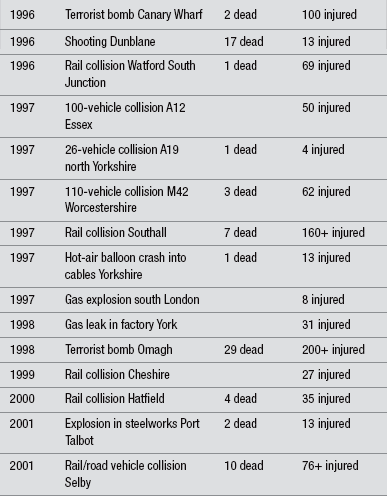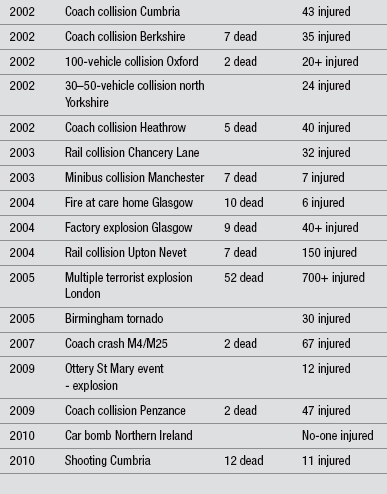Major incidents
Introduction
Incidents involving large numbers of injured individuals are not as uncommon as people may like to believe, although over the years the profiles of these incidents have changed. Incidents are often associated with industry, transportation, mass gatherings, and terrorism. Carley & Mackway-Jones (2005) found on average, 3–4 major incidents occurred in the UK every year from 1966 to 1996 (range 0–11). Table 3.1 lists a few examples of incidents occurring over the last 20 years in the UK.
This chapter discusses the role of the health services in contingency planning and service provision for major incidents. Consideration will be given to hospital-based activity, both in general terms and specifically in relation to in-hospital emergency services. The on-scene response to a major incident is considered in Chapter 1.
In England the primary source of guidance to assist the NHS in planning a response to a major incident is contained in the Department of Health Emergency Preparedness Division (2007) Mass Casualties Incidents: A Framework for Planning, which is influenced by the requirements of the Civil Contingencies Act 2004 (Home Office 2004). Guidance for Scotland, Wales and Northern Ireland is issued by the Health Departments of each of the Administrations.
Definition
Guidance from the Department of Health (HSE1996a,b) defines a major incident as: ‘any occurrence that presents serious threat to the health of the community, disruption to service, or causes (or is likely to cause) such numbers or types of casualties as to require special arrangements to be implemented by hospitals, ambulance trusts or primary care organizations’.
This definition reflects the departure from the view that major incidents only result from the ‘big bang’ scenario such as a rail collision or a building collapse. Guidance now recognizes that major incidents can also occur in a variety of different ways (NHS Management Executive 1998, National Audit Office 2002), such as
• rising tide – such as a developing infectious disease epidemic or an outbreak of Legionnaires’ disease (Smith et al. 2005)
• cloud on the horizon – a serious incident elsewhere that may develop and need preparatory action such as a cloud of toxic gas from a fire at an industrial plant
• headline news – public alarm about a personal threat
• internal incident – such as a fire in the hospital or power failure
• deliberate – such as the release of chemical, biological, radiation or nuclear material
• pre-planned major events – such as sporting or entertainment mass gatherings.
Planning
Each NHS organization must have a major incident plan based upon risk assessment, cooperation with partners, communicating with the public, and information sharing. It is the Chief Executive’s responsibility to ensure such a plan is in place and to keep the Trust Board up to date with the plan (Department of Health Emergency Preparedness Division 2005, 2011).
The plan should outline actions for the acute Trust to discharge its responsibilities, namely:
• provide a safe and secure environment for the assessment and treatment of patients
• provide a safe and secure environment for staff that will ensure the health, safety and welfare of staff, including appropriate arrangements for the professional and personal indemnification of staff
• provide a clinical response, including provision of general support and specific/specialist healthcare to all casualties, victims and responders
• liaise with the ambulance service, local Primary Care Organizations (PCOs) including GPs, out-of-hours services, Minor Injuries Units (MIUs) and other primary care providers, other hospitals, independent sector providers, and other agencies in order to manage the impact of the incident
• ensure there is an operational response to provide at-scene medical cover using, for example, BASICS and other immediate-care teams where they exist; members of these teams will be trained to an appropriate standard; the Medical Incident Commander should not routinely be taken from the receiving hospital so as not to deplete resources
• ensure that the hospital reviews all its essential functions throughout the incident
• provide appropriate support to any designated receiving hospital or other neighbouring service that is substantially affected
• provide limited decontamination facilities and personal protective equipment to manage contaminated self-presenting casualties
• acute Trusts will be expected to establish a Memorandum of Understanding (MOU) with their local Fire and Rescue Service on decontamination
• acute Trusts will need to make arrangements to reflect national guidance from the Home Office for dealing with the bodies of contaminated patients who die at the hospital
• liaise with activated health emergency control centres and/or on call PCO Officers as appropriate
• maintain communications with relatives and friends of existing patients and those from the incident, the Casualty Bureau, the local community, the media and VIPs.
Training
There is an expectation that staff understand the role they would adopt in a major incident, have the competencies to fulfil that role and have received training to fulfil those competencies. There is some evidence to suggest that staff are not entirely familiar with the action they should take in a major incident (Carr et al. 2006, Milkhu et al. 2008, Linney et al. 2011). It is suggested that acute Trusts should consider providing annual training and development for staff to enable them to meet these expectations. There is also a requirement for all NHS organizations to undertake a live exercise every three years, a table-top exercise each year and a test of communication cascades every six months (Department of Health Emergency Preparedness Division 2005). However, despite these exercises their must be a recognition for acute hospital trusts to coordinate their role with the surrounding primary healthcare organizations, as they may also lack in preparedness (Day et al. 2010).
Large-scale exercises serve a number of purposes:
• enabling major incident plans to be tested
• allowing the rehearsal of practical skills in realistic environments
• working alongside other services, establishing working relationships with individuals and organizations likely to be involved in a true response.








